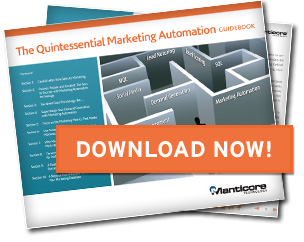On Thursday I’m presenting a webinar with Treehouse Interactive, called “Lead Nurturing 101”. One of the registrants sent me the following question:
How much of this webinar will be about content, i.e. exactly what to say in each subsequent email in a series designed to move someone from prospect stage to buying stage?
The webinar will only cover this briefly, so therefore I’m giving some more details this blog post. By the way, you can still register for the webinar.
What Is Lead Nurturing Content?
Lead Nurturing content contains information that prospects need to make a purchase decision. It can come in various formats: (blog) articles, whitepapers, webinars, videos, podcasts, and so on. The content can be on the vendor’s website, it can be sent out via email, or sent out by sales people. In this post I’ll focus on content that is sent out via automated email campaigns (drip campaigns).
Mapping Content to Buying Stages
Different people need different content at different times. You can develop buyer personas and describe the content they need in the various buying stages. This process is called ‘content mapping’. Steve woods wrote a great primer on content mapping. With content mapping you can make sure that you cover all questions and objections that typically come up during the buying process.
However, it can be hard to apply content mapping to email nurturing. On your website, prospects will select the content they find interesting themselves, but in an email you are making a choice for them. So how do know what content they need at what time?
One option would be to assume that all new leads are just starting their buying process and need 6 months to make a decision. But that’s not how it works in real life: different people have different needs and are on a different schedule. The solution is to learn more about your prospects before you decide what content to send to them.
Content for Nurturing Emails
So to send the right content by email, you need to monitor prospects’ behavior. Web visits, document downloads, form submissions and email clicks will all give you an indication of the stage prospects are in. Based on their actions, you can enter prospects in the most appropriate nurturing campaign.
For example, if prospects download a whitepaper on the trends in your industry, they may also be interested in analyst reports or customer case studies. Or if they register for a demo of your product, a logical next step my be a product trial or a free consultation.
Once prospects have been entered in a particular lead nurturing track, keep monitoring their responses. For example, if prospects who downloaded a whitepaper earlier are now registering for a demo, you may want to switch campaigns. When the drip campaign has come to an end before the prospects are ready to buy, enter them in a long-term nurturing campaign.
The Best Email Sequence
Now we’re getting to the heart of the matter. If you know the email campaign, how do you decide which content should be in it, and in which order? I can share some approaches that work well for me in my consulting practice.
To determine the pieces of content, make a list of all the questions people typically ask in this stage. If you don’t know, ask your sales people, or simply call a couple of prospects and ask them. Also try to find out typical objections. Ideally, you provide content that addresses all questions and objections that prospects have in this stage of the buying process.
In your email campaign, start with a couple of educational emails that contain helpful content. The tone-of-voice of these emails should also be helpful (as opposed to being sales-oriented). Then start mixing in some more promotional content, which could be offers or product-related content. Once the campaign is running, carefully monitor open rates and click rates so you can optimize your messages. You’ll have to iterate a couple of times: it’s hard to create the ‘perfect’ campaign from the start.
Keeping It Manageable
There are only so many campaigns that you can realistically create. How can you keep it all manageable? My first recommendation is to focus on the most promising customer segments first. It’s better to do a great job nurturing the most important 20% of your prospects than do a bad job nurturing your entire database.
Second, keep the campaigns relatively simple. A simple but consistently executed campaign will give better results than a complex campaign that is hard to manage. It’s often best to start with linear campaigns: just sending one message after another, rather than branching based on the prospect’s behavior.
Let me know your tips for creating email nurturing content!
Live Webinar: Lead Nurturing 101
Learn how to nurture your leads and bring more revenue to your company. This webinar shows what you can do today to begin or enhance your lead nurturing programs. Thursday at 1pm PDT.
Register now »
 Unfortunately, it’s really hard to find good copywriters for email. Most copywriters focus on whitepapers and press releases, fewer copywriters are good at direct marketing, and even fewer can apply direct marketing best practices to email marketing. And some of those are exclusively B2C.
Unfortunately, it’s really hard to find good copywriters for email. Most copywriters focus on whitepapers and press releases, fewer copywriters are good at direct marketing, and even fewer can apply direct marketing best practices to email marketing. And some of those are exclusively B2C.

